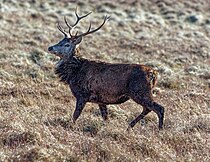Our website is made possible by displaying online advertisements to our visitors.
Please consider supporting us by disabling your ad blocker.
National scenic area (Scotland)

National scenic area (NSA) is a conservation designation used in Scotland, and administered by NatureScot on behalf of the Scottish Government. The designation's purpose is to identify areas of exceptional scenery and to protect them from inappropriate development. There are currently 40 national scenic areas (NSAs) in Scotland, covering 13% of the land area of Scotland.[1] The areas protected by the designation are considered to represent the type of scenic beauty "popularly associated with Scotland and for which it is renowned".[2] As such they tend to be mainly found in remote and mountainous areas,[1] with a review in 1997 noting a potential weakness of national scenic areas was that the original selection placed undue emphasis on mountainous parts of the country.[3] National scenic areas do however also cover seascapes, with approximately 26% of the total area protected by the designation being marine.[4] The designation is primarily concerned with scenic qualities, although designated national scenic areas may well have other special qualities, for example related to culture, history, archaeology, geology or wildlife. Areas with such qualities may be protected by other designations (e.g. national nature reserve) that overlap with the NSA designation.[5]
| Part of a series on the |
| Biodiversity of Scotland |
|---|
 |
National scenic areas are designated by the IUCN as Category V Protected Landscapes, the same international category as Scotland's two national parks.[1] Within the United Kingdom the NSA designation is regarded as equivalent to the Areas of Outstanding Natural Beauty (AONBs) of England, Wales and Northern Ireland.[1]
The national scenic area designation does not have a high profile when compared to other conservation designations used in Scotland: in 2018 a survey by the National Trust for Scotland found that only 20% of Scots were "definitely aware" of national scenic areas, compared to 80% for National Parks.[6]
- ^ a b c d "National Scenic Areas". NatureScot. Retrieved 3 September 2020.
- ^ "Countryside and Landscape in Scotland - National Scenic Areas". Scottish Government. 4 July 2017. Archived from the original on 31 January 2018. Retrieved 31 January 2018.
- ^ "National Scenic Areas Review" (PDF). Scottish Natural Heritage. 1997. Archived from the original (PDF) on 6 February 2018. Retrieved 5 February 2018.
- ^ Cite error: The named reference
areawas invoked but never defined (see the help page). - ^ "The special qualities of the national scenic areas" (PDF). Scottish Natural Heritage. 2010. Retrieved 28 April 2021.
- ^ "Scots want their scenic landscapes better protected". National Trust for Scotland. 7 November 2018. Retrieved 28 April 2021.
Previous Page Next Page


